Posted by: Northwest Eye in General on July 17, 2025
Overview
We understand that maintaining your eye health is a top priority. That’s why it’s crucial to grasp the concept of eye pressure, particularly intraocular pressure (IOP), which typically falls within a normal range of 10 to 21 mmHg. Regular monitoring and eye exams are vital, as abnormal IOP can lead to serious conditions like glaucoma. This condition affects millions and can result in irreversible vision loss if not detected early. We are here to help you through this process and encourage you to stay vigilant about your eye health.
Introduction
Understanding the nuances of intraocular pressure (IOP) is essential for maintaining optimal eye health. We recognize that many individuals may not be fully aware of its importance. Normal eye pressure typically ranges between 10 and 21 mmHg, and deviations can lead to serious conditions like glaucoma, which affects millions without their knowledge.
This article explores the significance of monitoring eye pressure, the factors that influence it, and the potential risks associated with abnormal levels. We understand that you may wonder how to ensure your eye pressure remains within a healthy range. What proactive steps can you take to safeguard your vision? We are here to help you through this process.
Define Eye Pressure and Its Importance in Eye Health
Intraocular tension (IOP) is the fluid force within your eye, playing a crucial role in maintaining its shape and overall health. We understand that many may feel concerned about their eye health, and it’s important to know that IOP is primarily regulated by the balance between the production and drainage of aqueous humor, the nourishing fluid of the eye. A healthy eye pressure range is generally between 10 and 21 mmHg; values outside this eye pressure range can lead to significant vision changes and conditions such as increased intraocular pressure, which is a primary cause of irreversible vision loss affecting over 3 million Americans. Elevated eye tension is a major risk factor for this disease, highlighting the necessity for regular observation.
It’s common to feel apprehensive about eye exams, but studies indicate that the mean IOP decreases with age, with a notable reduction of approximately 0.50 mmHg for each decade increase in age. This underscores the importance of monitoring the eye pressure range regularly, especially for older adults, as fluctuations can signal underlying health issues that may require intervention. For example, a recent study found that 92% of patients with primary open-angle eye condition had an IOP of 21 mmHg or lower, demonstrating that normal IOP does not eliminate the risk of the disease.
Furthermore, maintaining an optimal eye pressure range is essential for preserving your vision; untreated ocular hypertension can lead to a 9.5% risk of developing glaucoma within five years. Therefore, understanding IOP and its implications is vital for your eye health. We encourage and proactive eye care to safeguard your vision health. As Kathleen Gaines states, “Undergoing routine eye exams is crucial to your eye health.”
Additionally, the FDA has authorized the Diaton Tonometer for measuring IOP, providing a practical device for monitoring eye tension. It’s important to consider that systemic diseases can significantly influence IOP, further emphasizing the need for comprehensive eye care. Remember, we are here to help you through this process, ensuring you feel supported every step of the way.
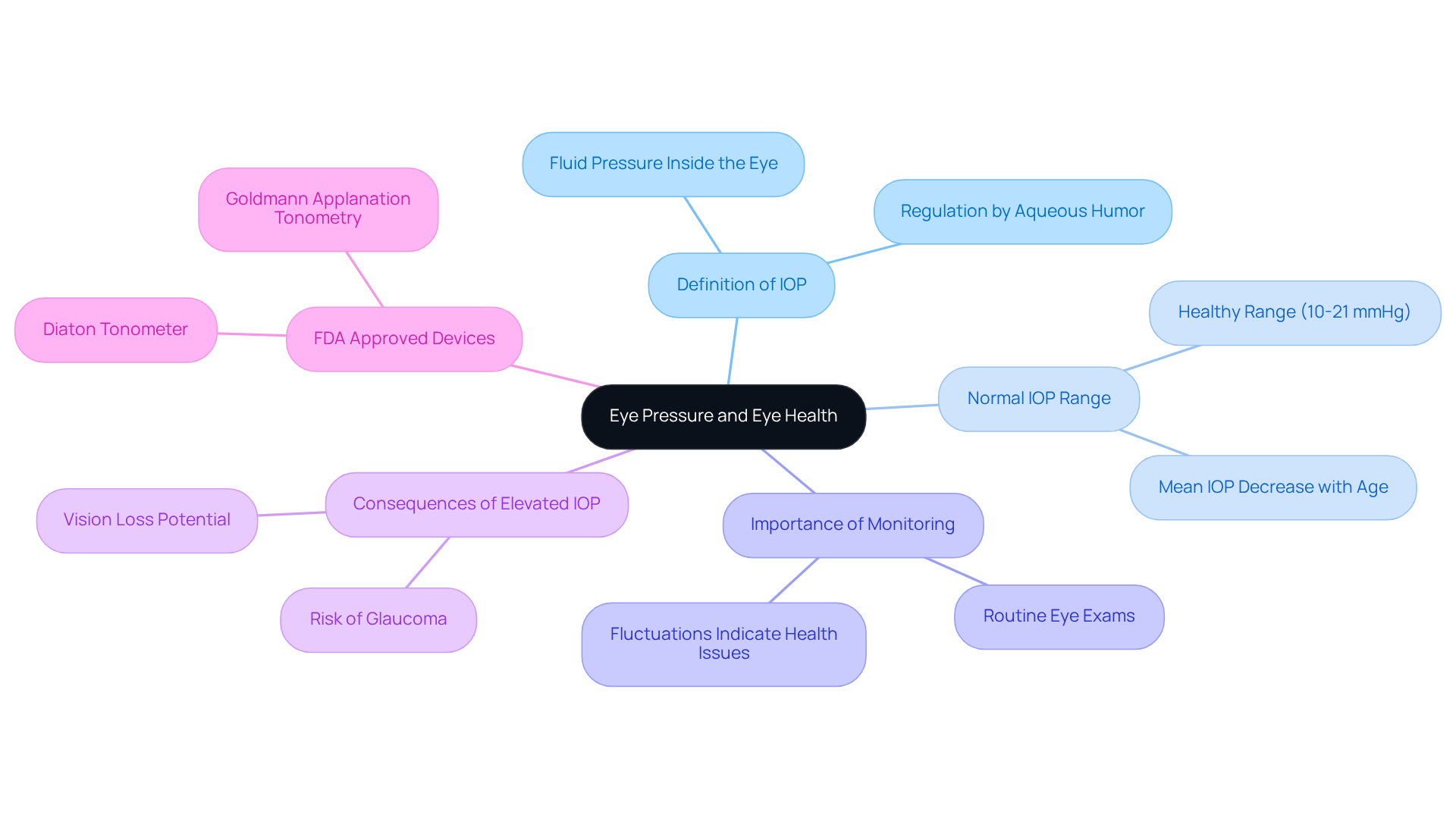
Explore Normal Eye Pressure Ranges and Their Implications
The normal eye pressure range typically falls between 10 to 21 mmHg (millimeters of mercury). We understand that many individuals may feel concerned about their eye health, especially since the (IOP) is around 15-16 mmHg. It’s common to worry about the eye pressure range values above 21 mmHg, as they are considered elevated and may indicate a risk for glaucoma. However, it’s important to recognize that some individuals can experience optic nerve damage at lower levels. This highlights the need for personalized assessments tailored to your unique situation.
Regular eye exams play a crucial role in establishing a baseline IOP and monitoring any changes over time. We encourage you to prioritize these check-ups, as they ensure timely intervention if necessary. Remember, we are here to help you through this process and support you in maintaining your eye health.
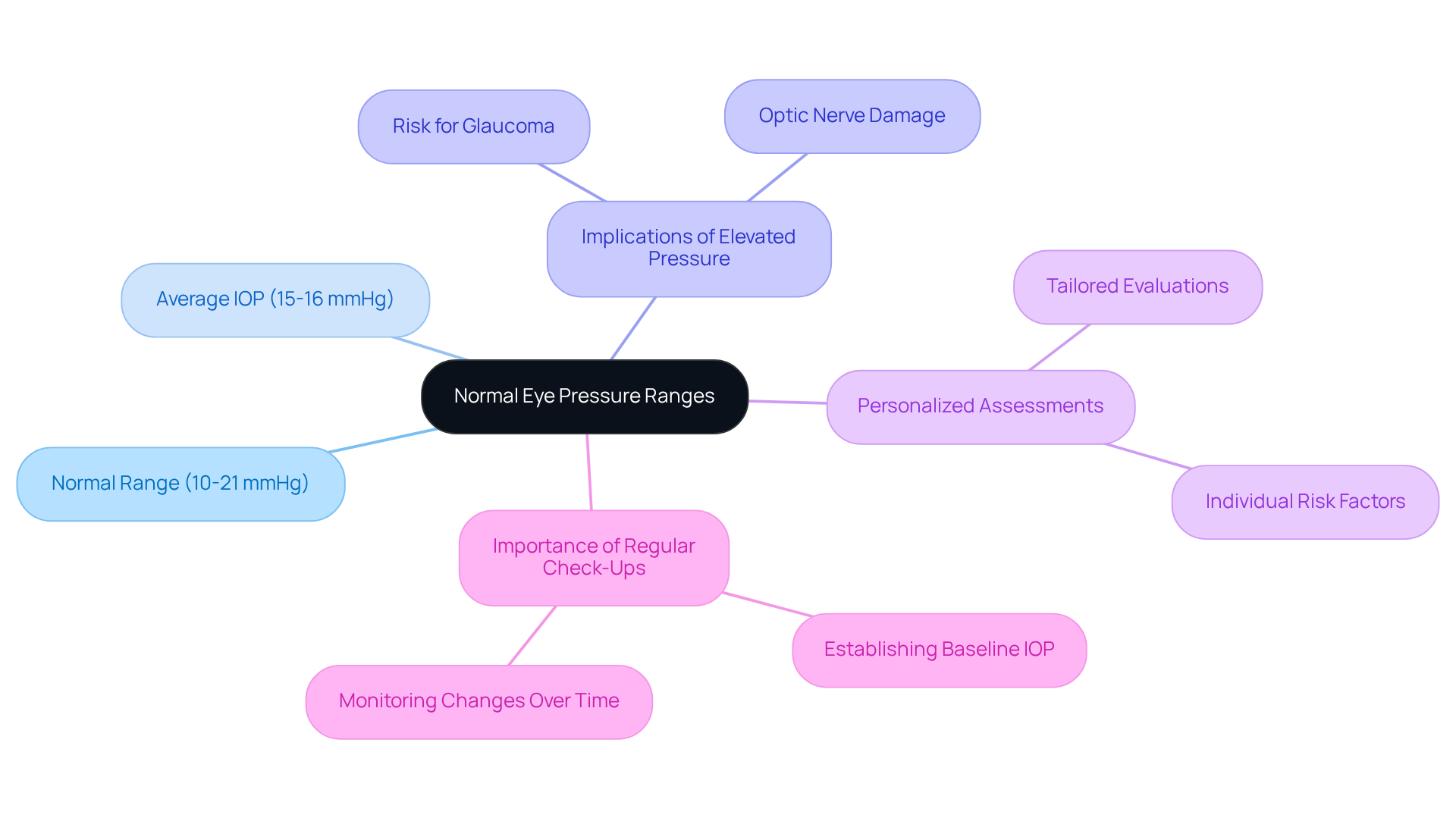
Identify Factors Affecting Eye Pressure Levels
The eye pressure range (IOP) is influenced by various factors, including age, genetics, and overall health. We understand that as people age, particularly those over 40, the risk of elevated IOP increases, which can lead to serious conditions such as eye damage, highlighting the importance of maintaining a . If you have a family history of eye disease, it’s important to be aware that your chances of experiencing elevated intraocular levels may exceed the normal eye pressure range. Research shows that when both parents have high intraocular levels, the likelihood of increased levels in their children can rise to as much as 76.1%.
Moreover, studies indicate that the heritability estimate for IOP is around 36%, highlighting the substantial genetic influence on this trait. Certain medications, especially corticosteroids, along with health conditions like diabetes and hypertension, can also contribute to an elevated eye pressure range. It’s common to feel concerned about these connections, but it’s worth noting that high IOP was not significantly associated with parental diabetes, hypertension, obesity, or metabolic syndrome, helping to clarify some misconceptions about systemic health conditions and IOP.
Lifestyle choices, including nutrition, physical activity, and stress management, play a crucial role in maintaining a healthy eye pressure range. By understanding these factors, you can make informed decisions about your eye health. Remember, we are here to help you through this process and encourage you to seek timely medical intervention when necessary. Your well-being is our priority.
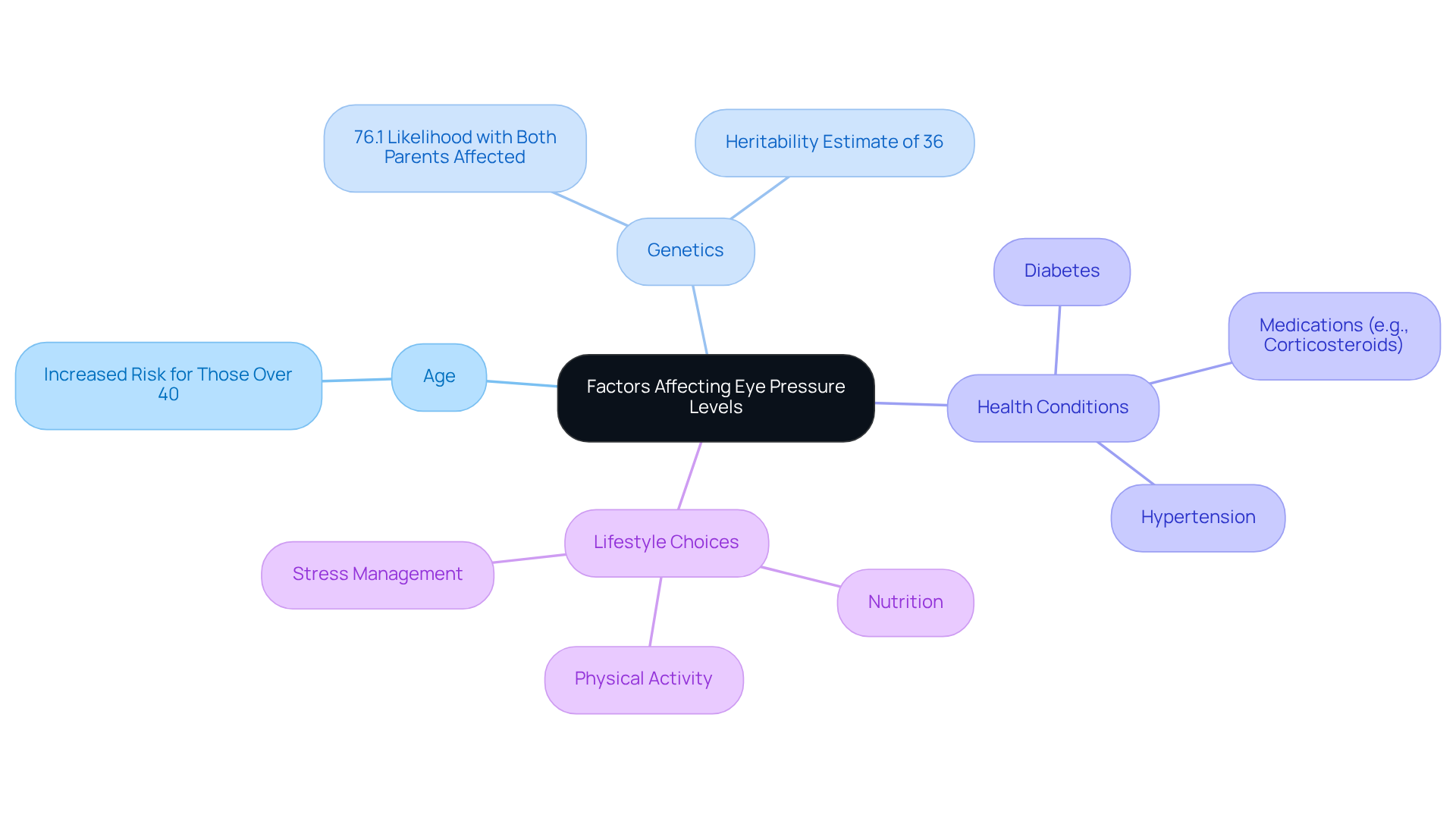
Understand Risks of Abnormal Eye Pressure and Related Conditions
Unusual eye tension can indicate a concerning eye pressure range, which is a significant risk factor for serious eye disorders, particularly elevated intraocular pressure, that can harm the optic nerve and potentially lead to gradual vision deterioration or irreversible blindness if not addressed. This eye condition is, in fact, one of the leading causes of blindness worldwide, affecting approximately 3 million Americans, many of whom are unaware of their situation. It’s important to recognize that Black individuals are 6 to 8 times more likely to develop eye conditions than White individuals, highlighting the need for vigilant monitoring of eye health in high-risk populations.
Conversely, low eye pressure, known as hypotony, can also result in vision problems, including structural damage to the eye. Recent findings indicate that individuals with diabetes are twice as likely to experience eye complications, underscoring the necessity for attentive eye health management.
Regular comprehensive eye exams are crucial for the early detection of these issues. A dilated eye exam stands out as the most effective method for identifying early signs of increased eye pressure range, allowing for timely intervention. Research shows that 50% of individuals with this eye condition are unaware they have it, which emphasizes the importance of heightened awareness and proactive eye care. Glaucoma accounts for over 10 million eye doctor visits each year, illustrating the widespread impact of this condition.
By addressing unusual eye tension through regular check-ups, patients can significantly reduce their risk of vision loss and protect their eye health. We understand that this can be concerning, but as Dr. Julie A. Carter states, “But here’s the good news: .” We are here to help you through this process and ensure your vision remains clear and healthy.
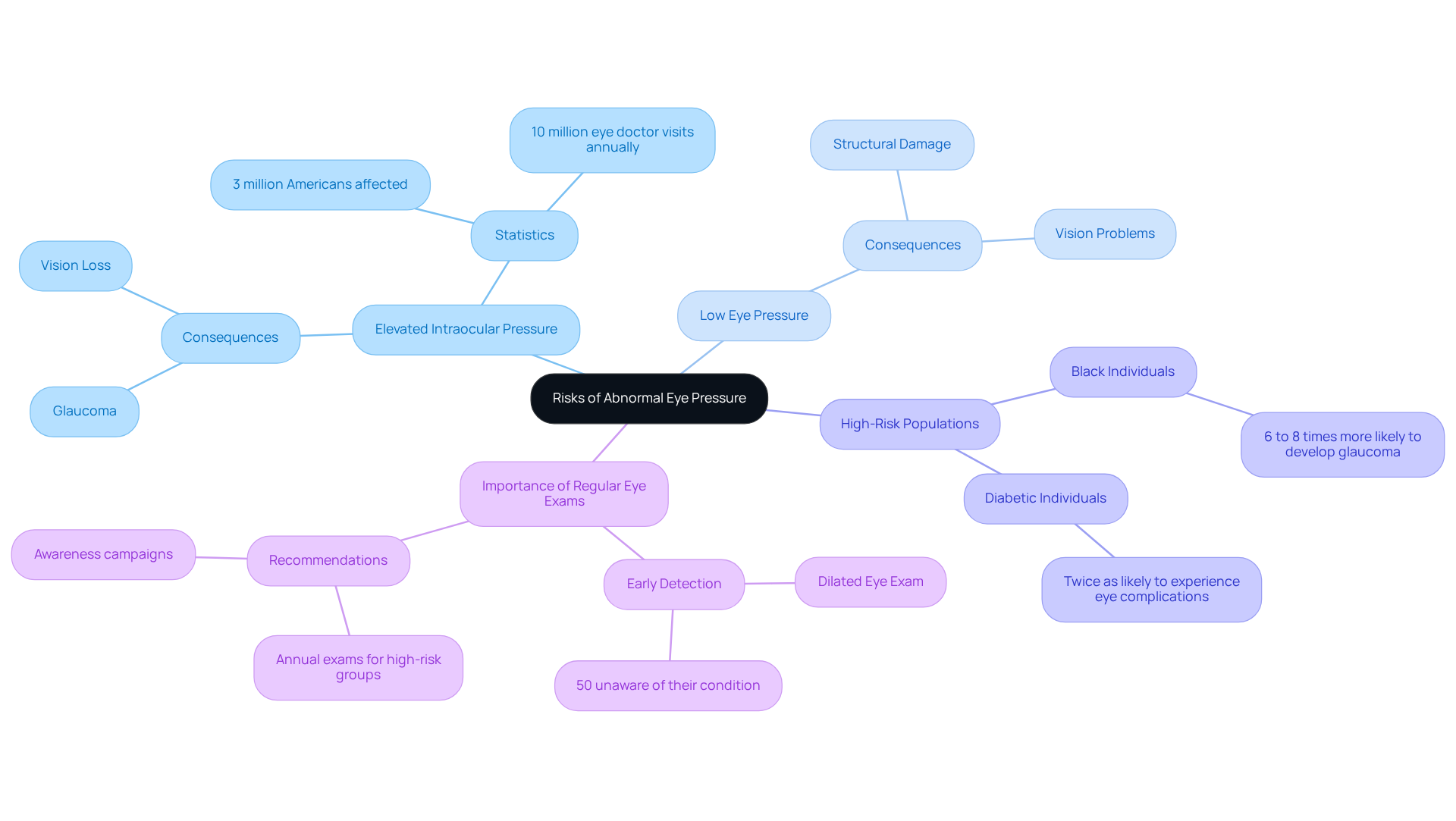
Learn How to Monitor Eye Pressure Effectively
Consistent observation of intraocular levels is essential for preserving eye wellness, especially for those who may feel vulnerable to eye disease. We understand that managing eye health can be daunting, but , the standard method for measuring intraocular pressure (IOP), is typically performed during visits to an eye care professional. This procedure provides accurate readings that are crucial for assessing eye health. For those who prefer convenience, home monitoring devices like the iCare HOME tonometer offer a user-friendly and painless alternative for measuring IOP.
Establishing a routine for checking IOP is vital, particularly for high-risk patients. Experts suggest that individuals with a history of increased eye pressure or ocular hypertension should consistently check their eye pressure range, preferably at least once a month. Keeping a detailed log of these measurements can help track fluctuations in your eye pressure range over time, enabling you to engage in informed discussions with your eye care provider about potential adjustments in your treatment plan.
Recent advancements in home monitoring technology have made it easier for patients to manage their eye health. Devices such as the iCare HOME2 have demonstrated good reliability and ease of use, allowing patients to capture IOP readings conveniently. It’s common to feel uncertain about self-monitoring; notably, a study found that four patients were excluded due to their inability to obtain at least 50% of reliable self-IOP measurements, highlighting the challenges some may face. Furthermore, the mean difference between Goldmann applanation tonometry (GAT) and iCare Home2 was −0.28±1.57 mmHg, indicating that while home monitoring is effective, it is essential to consider the accuracy of readings in comparison to traditional methods. These tools not only facilitate continuous monitoring but also empower you to take an active role in your eye care, ultimately leading to better management of conditions like glaucoma.
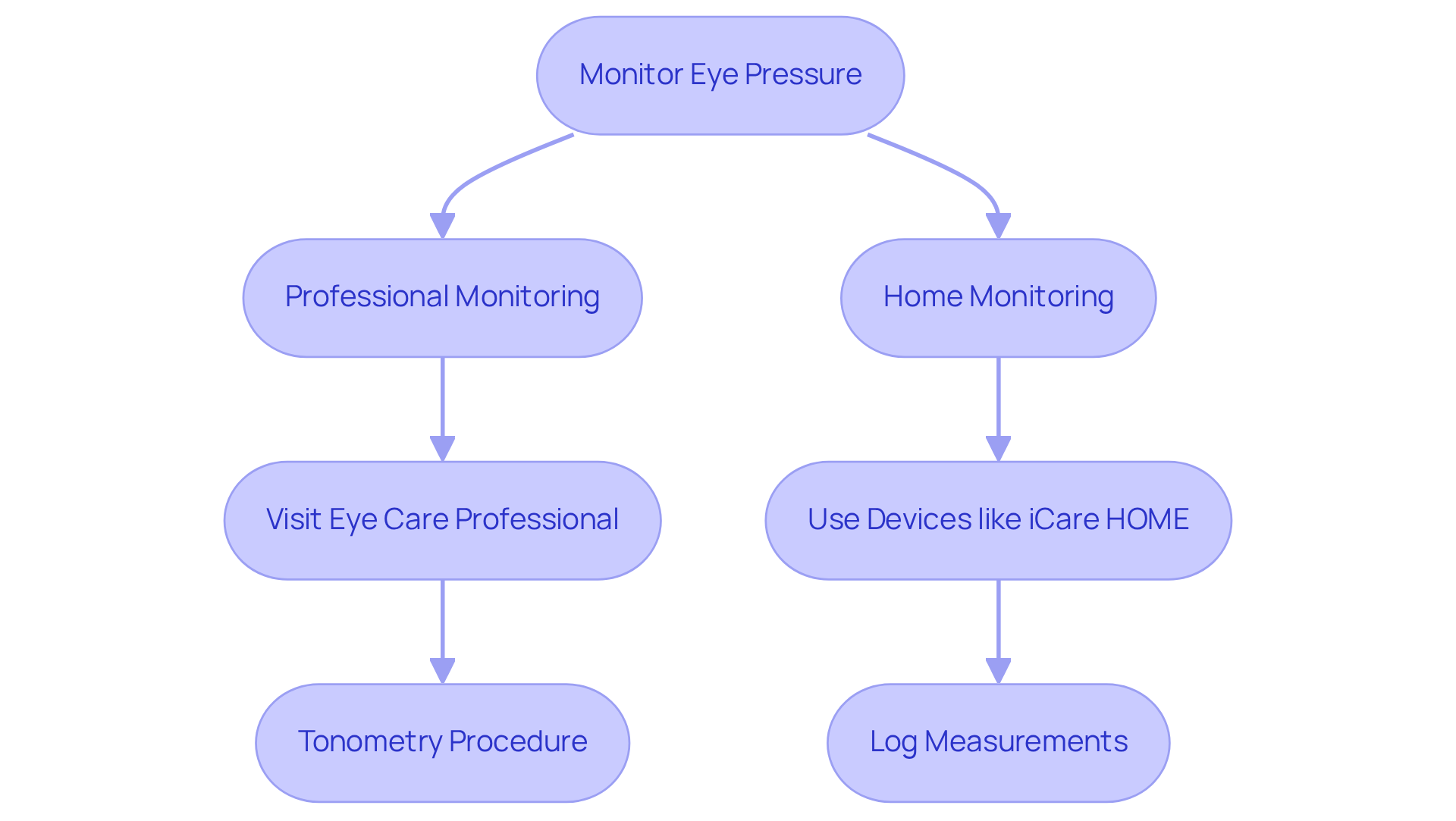
Conclusion
Understanding the intricacies of eye pressure and its implications for health is essential for maintaining optimal vision and preventing serious eye conditions. We recognize that intraocular pressure (IOP) is not merely a number; it is a critical indicator of overall eye health that requires regular monitoring. Maintaining IOP within the normal range of 10 to 21 mmHg is vital, as deviations can lead to irreversible vision loss, including conditions like glaucoma, which affects millions.
Key insights from our discussion highlight the various factors that influence IOP, such as age, genetics, and lifestyle choices. It’s important to understand that even normal eye pressure does not eliminate the risk of developing eye diseases. Regular eye exams and proactive monitoring of IOP can significantly reduce the risk of vision loss, particularly for individuals at higher risk due to family history or existing health conditions. The advancements in home monitoring technologies empower you to take charge of your eye health, making it easier to track changes and communicate effectively with healthcare providers.
In conclusion, prioritizing eye health through routine check-ups and awareness of eye pressure is not just a recommendation; it is a necessity for preserving vision and overall well-being. We understand that taking these steps can feel overwhelming, but by fostering a proactive approach to eye care, you can mitigate risks associated with abnormal eye pressure and ensure a brighter, clearer future. Embracing the importance of regular eye exams and understanding the factors that affect IOP can lead to informed decisions and better eye health management. We are here to help you through this process.
Frequently Asked Questions
What is intraocular pressure (IOP) and why is it important?
Intraocular pressure (IOP) is the fluid force within the eye, crucial for maintaining its shape and overall health. It is regulated by the balance between the production and drainage of aqueous humor. Maintaining a healthy IOP range is essential to prevent significant vision changes and conditions like glaucoma.
What is the normal range for eye pressure?
The normal eye pressure range typically falls between 10 to 21 mmHg, with the average IOP being around 15-16 mmHg.
What can happen if eye pressure is outside the normal range?
Values outside the normal eye pressure range can lead to significant vision changes and conditions such as increased intraocular pressure, which is a primary cause of irreversible vision loss, particularly glaucoma.
How does age affect intraocular pressure?
Studies indicate that mean IOP decreases with age, with an approximate reduction of 0.50 mmHg for each decade increase in age. This makes regular monitoring of eye pressure particularly important for older adults.
What is the risk of developing glaucoma related to untreated ocular hypertension?
Untreated ocular hypertension can lead to a 9.5% risk of developing glaucoma within five years.
How can I monitor my eye pressure?
The FDA has authorized the Diaton Tonometer for measuring IOP, providing a practical device for monitoring eye tension.
Why are regular eye exams important?
Regular eye exams are crucial for establishing a baseline IOP, monitoring changes over time, and ensuring timely intervention if necessary. They help in safeguarding overall eye health.
Can systemic diseases affect intraocular pressure?
Yes, systemic diseases can significantly influence IOP, highlighting the need for comprehensive eye care.






